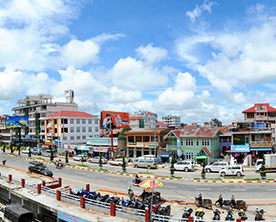Myanmar, which has previously lagged behind neighboring Asian nations in terms of urbanisation, is in the midst of a population boom in its major cities of Yangon, Mandalay, Naypyidaw, Mawlamyine and Taunggyi. In the coming years, this trend is likely to continue as Myanmar develops both economically and technologically. It is imperative that Myanmar begins now to take necessary measures to ensure optimal urban growth and management in order to avoid any societal problems that may result from an unorganized, chaotic urban landscape.
The urban community of Myanmar shared a mere 30 percent of the total population according to the 2014 Myanmar census, which can be categorised as low in both global and ASEAN index. In terms of individual urban hubs, Myanmar has no large urban centres by East Asian standards as of 2010, according to the World Bank. But with continuous, striking developments in political, social and economic aspects driving the socio-economic paradigm shifts, a dynamic form of rural-urban migration has been evident nationwide in recent years.
The World Bank indicator of urban population for countries estimated the overall number of urban inhabitants in Myanmar to be 34.1 percent of the total population in 2015, a notable 4.1 percent increase from 2014. Prior to 2015, the growth urban growth rate stood at 2.9 percent.
Myanmar’s Growing Urban Areas
The cities of Yangon, Mandalay, Naypyidaw, Mawlamyine and Taunggyi are Myanmar’s leading urban centres in accordance with their larger populations and pre-eminent urban developments. Yangon, the largest city and most important commercial hub in the country, has a population of 5.1 million according to the 2014 census. The figure covers just the urban population of the city, referring those who reside in parts of the former capital dubbed by some as Greater Yangon that are more downtown and have more advanced urban development than other spanning metropolitan parts. In respect of the entire metropolitan area, the population of Yangon reaches nearly 6 million and the Yangon Region as a whole has a population of 7.36 million.
The second largest city Mandalay has an urban population of over 1 million. The current capital Naypyi daw, which comprises three pre-existing townships and five newly-established townships, has an overall urban population of approximately 1 million. The urban populations of Mawlamyine and Taunggyi are around 260,000 each according to the census.
Until the early 2010s, Myanmar’s urban population growth was faster than spatial growth that the population density of urban areas in Myanmar could be seen higher than the average for urban areas in the entire East Asia region, with density increasing from 6,200 per square kilometer in 2000 to 7,500 in 2010. For example, Yangon’s spatial growth during that decade was only at a rate of 0.5 percent a year, from 370 square kilometers in 2000 to 390 in 2010. And although all of the aforementioned cities have been gaining momentum in urbanisation, the process is found to be majorly Yangon-centric. Successive waves of migrated populations from all parts of the country have been continuously thronging the biggest city year by year in decades that the strategic urban centre is made home to a considerable percentage of the country’s total population, making the size of the city’s populace greatly larger than that of any other urban areas in Myanmar.
In order to ensure sustainable urbanisation, it is crucial to take timely actions that deal with proactive approaches to prevent neglected, disordered urban growth.










